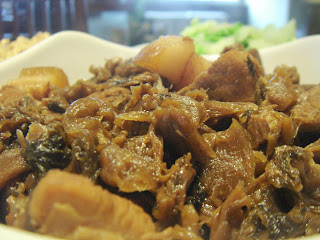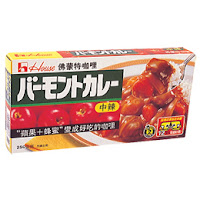
Don't belittle this bad-looking dish. Even though it looks dirty and decayed, it's a famous Chinese course. We call it "Buckle Pork with Mei-gan", which directly translated from Chinese name. Mei-gan is a sort of pickled vegetable and sounds like a female's name "Megan" :p I will introduce Mei-gan vegetable and explain why named "Buckle Pork".##CONTINUE##
A classical "Pork Steamed with Pickled Mustard Cabbage" is a time-consuming dish and need a complex procedure. According to my grand mom's recipe: besides choosing a good
pork side, the side with skin, fat meat, and lean meat have to be layers of clear. So that Chinese call this cut "Five Pattern Pork" or Taiwanese call "Three Layers Pork", which comes from multiple layers characteristic. In restaurants or for banquet, the cook would cut into thick slice for beauty. But my mom just cuts into cube as thumb size. It's convenience for eating and without chopping them.
Before stewing, the pork would be taken to deep-fried in order to seal up the meat juice and avoid over cooking. The next step is to stew them with soy sauce and other seasonings, almost similar to "
Stewed Pork with Brown Sauce". This step seems to be a groundwork of meat cooking. The color, luster and the taste, texture all depend on this stew process.
After that, neatly and separately arrange pork slices on the plate and put Mei-gan vegetable onto meat. Then place it into steamer and wait. Finally, after steamed pork is done, put another plate upside down on the top and buckle two plates with your hands and then turn them over. While you take the above plate away, a delicious "Buckle Pork with Mei-gan" is done. Now you understand where the name "Buckle" comes from.
You must be curious what the Mei-gan vegetable is. The title leaks answer. It made by a sort of
Mustard Cabbage, whose seeds can process to mustard. Chinese pickle leaves with salt and then dry them until black. The "gan" of Mei-gan (乾) means "Dry". The "Mei" has two stories. The first "Mei" (霉) means "Mold" and describe its moldy appearance. The other "Mei" (梅) is "
Ume". According to legend, Chinese made Mei-gan vegetable when the fruit of Ume is ripe.


 You can understand the key point of Taiwan mooncake from its local name: "yolk" and "pastry".
You can understand the key point of Taiwan mooncake from its local name: "yolk" and "pastry".
